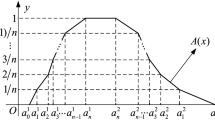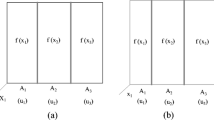Abstract
The single-input single-output or multi-input single-output polygonal fuzzy neural network can accomplish some information disposing based on a finite number of points of polygonal fuzzy number. Although it does not depend on a precise mathematical model, it involves logical reasoning, numerical calculation and nonlinear functional approximation. The multi-input multi-output (MIMO) polygonal fuzzy neural network model is proposed for the first time in this article. The two different algorithms are designed in the input layer and hidden layer, respectively, and some parameters of the connection weights in the isolation layered manner can be optimized. Particularly, the neurons in the hidden layer are optimized one by one. Results showed that the isolation layered optimization algorithm of MIMO polygonal fuzzy neural network could improve the computational efficiency and convergent rate.











Similar content being viewed by others
Explore related subjects
Discover the latest articles, news and stories from top researchers in related subjects.References
Aliev RA, Guirimov BG, Fazlollahi B, Alive RR (2009) Evolutionary algorithm-based learning of fuzzy neural networks. Part 2: recurrent fuzzy neural networks. Fuzzy Sets Syst 160(17):2553–2566. doi:10.1016/j.fss.2008.12.018
Anitha J, Jude HD (2013) An efficient Kohonen-fuzzy neural network based abnormal retinal image classification system. Neural Netw World 23(2):149–167. doi:10.14311/NNW.2013.23.011
Chung FL, Duan JC (2000) On multistage fuzzy neural network modeling. IEEE Trans Fuzzy Syst 8(2):125–142. doi:10.1109/91.842148
Er MJ, Wu S, Gao Y (2001) A fast approach for automatic generation of fuzzy rules by generalized dynamic fuzzy neural networks. IEEE Trans Fuzzy Syst 9(4):578–594. doi:10.1109/91.940970
Chen TP, Chen H (1993) Approximation of continuous functionals by neural networks with applications to dynamic systems. IEEE Trans Neural Netw 6(4):910–918. doi:10.1109/72.286886
Feuring T, Lippe WM (1999) The fuzzy neural network approximation lemma. Fuzzy Sets Syst 102(2):227–237. doi:10.1016/S0165-0114(97)00125-5
Liu PY (2001) Universal approximation of continuous analyses fuzzy valued functions by multi-layer regular fuzzy neural networks. Fuzzy Sets Syst 119(3):313–320. doi:10.1016/S0165-0114(99)00132-3
Rumelhart DE, Hinton CE, Wiliams RJ (1986) Learning representations by back-propagating errors. Nature 323(9):533–536. doi:10.1038/323533a0
Tian CJ, Wei G (2001) A new layer-wise linearized algorithm for feedforward neural network. Acta Electron Sin 29(11):1495–1498
Xie H, Cheng HZ, Niu DX, Zhang GL (2005) A fast learning algorithm for feedfoward neural network based on the layer-by-layer and neuron-by-neuron optimizing procedure. Acta Electron Sin 33(1):111–114
Tao YQ, Cui DW (2011) Load identification of algorithm based on dynamic fuzzy granular neural network. Control Decis 26(4):519–523+529
Wu JL, Zhang BH, Wang K (2012) Application of adaboost-based BP neural network for short-term wind speed forecast. Power Styst Technol 36(9):221–225
Zhou Y, Wang S, Gao CS, Sun WC (2010) An improved PSO-based fuzzy neural network and its application in short-term weather forecast. Comput Appl Softw 27(5):234–237
Liu PY (2002) A new fuzzy neural network and its approximation capability. Sci China Ser E 32(1):76–86
He CM, Ye YP (2011) Evolution computation based learning algorithms of polygonal fuzzy neural networks. Int J Intell Syst 262(4):340–352. doi:10.1002/int.20469
Wang GJ, Li XP (2011) Universal approximation of polygonal fuzzy neural networks in sense of \(K\)-integral norms. Sci China Inf Sci 54(11):2307–2323. doi:10.1007/s11432-011-4364-y
Wang GJ, Li XP (2014) Construction of the polygonal fuzzy neural network and its approximation based on K-integral norm. Neural Netw World 24(4):357–376. doi:10.14311/NNW.2014.24.021
He Y, Wang GJ (2012) Conjugate gradient algorithm of the polygonal fuzzy neural networks. Acta Electron Sin 40(10):2079–2084. doi:10.3969/j.issn.0372-2112.2012.10.029
Sui XL, Wang GJ (2012) Influence of perturbations of training pattern pairs on stability of polygonal fuzzy neural network. Pattern Recognit Artif Intell 26(6):928–936
Yang YQ, Wang GJ, Yang Y (2014) Parameter optimization of polygonal fuzzy neural networks based on GA-BP hybrid algorithm. Int J Mach Learn Cybernet 5(5):815–822. doi:10.1007/s13042-013-0224-y
Wang GJ, He Y, Li XP (2015) Optimization algorithms for MISO polygonal fuzzy neural networks. Sci China Inf Sci 45(5):650–667. doi:10.1360/N112013-00214
Acknowledgment
This work has been supported by National Natural Science Foundation China (Grant No. 61374009).
Author information
Authors and Affiliations
Corresponding author
Rights and permissions
About this article
Cite this article
Wang, G., Suo, C. The isolation layered optimization algorithm of MIMO polygonal fuzzy neural network. Neural Comput & Applic 29, 721–731 (2018). https://doi.org/10.1007/s00521-016-2600-5
Received:
Accepted:
Published:
Issue Date:
DOI: https://doi.org/10.1007/s00521-016-2600-5




